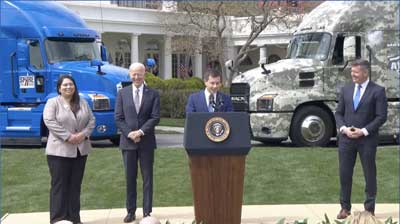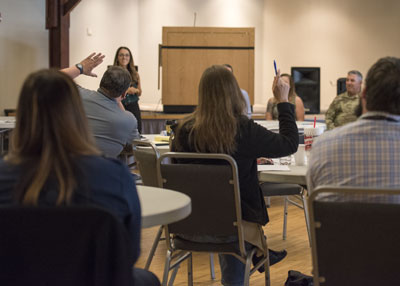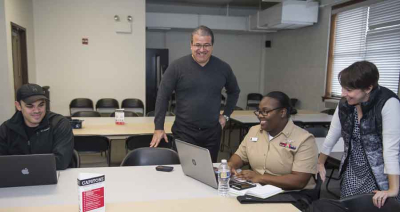When America’s Economy Is in Turmoil, Veterans Can Step up to Lead the Charge
Just before Christmas in 2021, employees at Lincoln College, a predominantly Black institution in central Illinois, came into work to find their printers had started printing on their own. All across campus, they spit out the same message: Hackers had taken control of the college’s systems and locked employees out. To regain access to the systems—which controlled academics, finances, fundraising, and more—the college would need to pay a hefty ransom.

Professor Bart Miller, a Vilas Distinguished Achievement Professor and the Amar and Belinder Sohi Professor of Computer Sciences at the University of Wisconsin-Madison, presents information about the ransomware landscape to Wisconsin National Guard leaders and cyberprofessionals at Joint Force Headquarters in Madison Nov. 4. Photo courtesy of the Wisconsin National Guard.
Lincoln College, like many smaller educational institutions, had already been struggling. The Covid-19 pandemic had compounded years of declining admissions. But the ransomware attack, which school officials believe originated in Iran, was the final blow. Although Lincoln College paid the ransom, it took almost two months to fully regain control over its various systems. By then, the damage was done. The attack made the school’s financial and student enrollment woes worse, and in the spring of 2022, Lincoln College closed its doors—the first higher education institution in the United States to close down in part because of a ransomware attack, according to NBC News.
Attacks like these are increasing in the United States and around the world. In 2021, more than 1,600 cyberattacks per week, on average, targeted higher educators and researchers—a 75% increase over the previous year. Colleges and universities are not alone. In 2021, cyberattacks on hospitals and health care systems impacted more than 45 million patients and their personal data. Every industry now faces an onslaught of increasingly sophisticated schemes targeting data, computer-controlled systems, personally identifiable information, and more.
But one group stands to benefit from this and other problems the nation faces as industries attempt to find skilled tech workers, employees retire out of traditional fields, or companies deal with the fall-out from the pandemic: veterans. Not only do they have the skills employers need, but they’re used to dealing with challenges, experts say.
As the tidal wave of cybercrime builds, more than three-quarters of a million cybersecurity positions go unfilled in the United States, even as nearly half of all Americans have had their personal information exposed by cybercriminals. Malware infects almost one out of three households with computers. And in 2021, Americans lost a staggering $8.3 billion to cyberattacks, a figure that is only expected to climb.
“You have to have discipline,” says Robert Vaughn, the chief innovation officer at NPower, of the skills needed to protect computer systems. “You have to understand structure. You’ve got to be flexible and agile. You have to know how to learn something fairly quickly, and then become a subject matter expert, but you also have to follow procedures. Those are things that veterans obviously are taught and [have] instilled in them.”
NPower, a digital skills nonprofit that trains veterans and workers from underserved communities, is one of an expanding number of organizations working to shore up the military-to-civilian workforce pipeline, helping to staff critical industries by not just providing job training but also by specifically helping veterans overcome other challenges that can accompany the transition to civilian life.

Former Undersecretary of the Army Patrick Murphy finishes a tandem jump with The Golden Knights during the 82nd Airborne Division Review on Drop Zone Sicily on May 26, 2016, at Fort Bragg, North Carolina. Murphy now works to connect veterans to jobs. Photo by Pfc. Hubert D. Delaney III, courtesy of the U.S. Army.
From cybersecurity to trucking to health care, essential industries—still reeling from the pandemic and the resulting economic turmoil—benefit from veteran employees, who have myriad relevant experience and can learn quickly, adjusting on the job. And a clear understanding of what veterans need to succeed in the civilian workplace, honed over the last two decades of war, helps veteran workers succeed in civilian companies—and has pushed what was once persistently high veteran unemployment rate below the civilian average.
“I’ve learned more than I’ve taught from veterans on how to respond to pressure and how to adapt to things that change quickly,” Vaughn says. “We know that these are not only worthy workforce candidates—we think that they literally are some of the best workforce candidates.”
‘There’s a Lot of Misconceptions’
In 2021, as the economy reopened after the Covid-19 shutdown, one of the many issues bottlenecking the supply chain was a shortage of truck drivers. Trucks move nearly three-quarters of the goods in America around the country. But the trucking industry found itself a record 80,000 truckers short.
Many truck drivers, who tend to be older, retired during the pandemic. Earning a commercial driver’s license can set a future employee back $8,000 to $10,000, and low pay has long plagued the industry. And many potential drivers don’t want to live life on the road.
But in recent years, those problems have been more perception than reality.

Secretary of Transportation Pete Buttigieg, center, with President Joe Biden, left, truck driver Maria Rodriguez, far left, and former Undersecretary of the Army Patrick Murphy announce the creation of Biden’s Trucking Action Plan in April 2022. Still shot from video courtesy of the White House Office of Communications.
“There’s a lot of misconceptions,” says Patrick Murphy, the former congressman and undersecretary of the Army. The growth in the e-commerce industry, and the optimized way goods are now moved, mean many truckers eat dinner at home most nights. The average starting salary for a new truck driver has climbed—and, at $77,000, stands at the highest it’s ever been.
In the spring of 2022, President Biden tapped Murphy to head up a key component of the administration’s Trucking Action Plan: connecting veterans to jobs driving the nation’s trucks. Some 70,000 veterans have recent trucking experience.
“If you can handle a tank, if you can handle an armored personnel carrier, you sure in hell can handle one of these suckers,” Biden said in announcing the plan. The result, a public-private partnership called Task Force Movement, has raised more than $9 million to help veterans secure their commercial driver’s licenses.
Then the administration reached back out to Murphy.
“The White House said, ‘Hey, you guys are cooking with Crisco when it comes to trucking,’” Murphy says. They wanted to know if he could help head up a similar task force for cybersecurity.
“In a country like ours that has the No. 1 economy, and the No. 1 military in the world, and we see our adversaries trying to penetrate not just corporations, but also the Pentagon—we need leaders,” Murphy says. The new initiative follows a similar model to help connect veterans with training and jobs in cybersecurity.
Murphy and others say veterans are not a panacea to solving the nation’s employment challenges.
“We know 125,000 people a year get out of the service,” says Michael Bianchi, the senior director of education and career training at the D’Aniello Institute for Veterans and Military Families at Syracuse University. “That’s not a significant number.” But employers want to hire veterans, and veterans tend to be well-positioned to transition into industries with critical shortfalls, they say.
Award-Winning Journalism in Your Inbox
Because military experience is so broad, veterans have likely been exposed to a range of skills—like driving trucks. Many recently separated veterans already hold security clearances, a boon for cybersecurity employers. And both trucking, which requires a commercial driver’s license, and cybersecurity, where specific certifications can open doors, are among the growing career fields that do not require advanced degrees.
“The United States is transitioning to a skills-based workforce,” Bianchi says. “So that master’s degree that we paid a lot of money for may not have as much bearing as someone who [is] experience-based.”
Sometimes, those military experiences are a clear parallel to skills civilian employers want to see. But sometimes they’re not.
“I flew the Apache, and in many ways, if I get too narrow on what skills that I employed in doing that, I’m a pretty unemployable person,” says Ross Dickman, the chief operations officer of Hire Heroes USA, which helps veterans and military spouses navigate the job search process. “Most companies don’t need someone to fly an armored tank that shoots missiles.”

Local business owners attend a Hiring Heroes seminar at Gowen Field, Boise, Idaho, in 2018, to learn more about hiring veterans. The four-hour seminar focused on the unique ways potential employers could advertise jobs and conduct interviews with veterans, as well as why they should hire them. Photo by Master Sgt. Joshua C. Allmaras, courtesy of the U.S. Air National Guard.
But taking a step back reveals a different reality. “What skills were you actualizing that weren’t on the surface?” Dickman says. “How did you manage people, workflow, maintenance, processes, mission planning?”
Dickman says even for veterans who want to embark on a career entirely different from their military specialty—up to 50% in some career fields—military veterans have soft skills employers want.
“You can get a diverse workforce that has that specific technical acumen,” Dickman says. “But they’ve also been trained … as a leader, how to communicate effectively, how to problem solve and manage on the fly when things change. … The capability to learn, the capability to adjust and learning agility that they bring, and the kind of resilience that veterans have, are some of the most critical soft skills that employers are looking for right now.”
‘It’s a Partnership to Do That Warm Handoff’
Thirteen years ago, in March 2010, the unemployment rate for veterans sat at nearly 10%. This February, it was 2.5%—lower than the overall national average. Over the last 13 years, as veterans have come home from overseas wars, the veteran unemployment rate has trended steadily downward (with the exception of a spike during 2020, in the early months of the pandemic).
Advocates who work with veterans during and after their transition from the military say both the supply and demand side worked to bring down the unemployment rate: educating and preparing companies for the needs of veterans, and connecting veterans with resources to both prepare for the civilian workforce and to deal with the overall stressors of moving from military to civilian life.
“It’s the partnership between the employers, between organizations like ourselves, and the job seekers to really do that warm handoff,” Bianchi says. “It’s a coalescence, really, around one singular mission, and that is to…prepare the veterans and the service members.”
Organizations like Hire Heroes USA, NPower, Onward to Opportunity, or the Institute for Veterans and Military Families’ career training program for veterans and military spouses provide critical specialized training and certifications, depending on a veteran’s background and interests, as well as job search support, such as career coaches and interview prep. But they also help veterans access broader support resources, such as mental health and housing support, or assistance navigating benefits.
“Organizations like ourselves, and many, many others in the space now, really work very hard to take transition on as not just a singular event, but as a process,” Bianchi says.

Retired Capt. John Malfitano, program manager of Onward to Opportunity, center, conducts an orientation session with a group of service members in 2016 at Naval Station Norfolk, Virginia. The program was created to train and connect transitioning service members and their spouses with employers. Photo by Petty Officer 2nd Class Bill Dodge, courtesy of the U.S. Navy.
Still, many advocates sound a note of caution about the successes reflected in labor statistics over the past decade, saying there is more work to be done.
“[T]he veteran unemployment rate looks really good, and has continued to do great things, and I’m not discounting that by any stretch,” Dickman says. But he points to a problem not addressed in government unemployment statistics: underemployment, or a mismatch of skills and earning potential with the job someone is in. While the veterans’ unemployment rate has stayed low in recent years, some research puts the underemployment rate among veterans as high as 61%.
“That falls disproportionately on younger veterans, enlisted veterans, minority veterans, women veterans,” Dickman says. “I think there’s a lot more work to be done on understanding and serving those audiences.”
Our Journalism Depends on Your Support
Still, he and others are hopeful that ultimately a similar formula for supporting veterans broadly and helping them leverage their military experiences can help eventually bridge that gap and strengthen the workforce in critical industries—like cybersecurity, where the supply is low, and the demand is very high.
“When I talk to our current and past students, they’re like, ‘Oh, this is natural for me, because this was a way for me to feel like I was protecting my family, our school systems, our utilities, our country—all of those things,’” Vaughn says. “The impact has been amazing.”
This War Horse feature was reported by Sonner Kehrt, edited by Kelly Kennedy, fact-checked by Jasper Lo, and copy-edited by Mitchell Hansen-Dewar. Headlines are by Abbie Bennett.





Comments are closed.